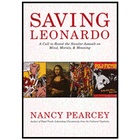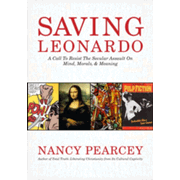Reading Saving Leonardo by Nancy Pearcey felt like I was revisiting Francis Schaeffer's classic book How Should We Then Live? that was first published in 1976. I’ve recommended Schaeffer’s book to many people over the years, but always with a caveat that “this is a challenging book.” Saving Leonardo is a much more accessible presentation of the battle between worldviews that should appeal to a much broader audience.
Pearcey adopts Schaeffer’s “upper and lower story” analogy to show how modern cultures have largely separated science, fact, and reality in the lower story from imagination, feelings, opinion, faith, and religion in the upper story. The dominant global secularism gives credence to the lower story, but dismisses the upper story as unknowable—a realm where “truth” doesn’t apply. Yet, many people operate out of the upper story in their morality, religious beliefs, and decision making while denying any inherent truth behind what they believe and the choices they make.
In Saving Leonardo, Pearcey first demonstrates the dominance of secularism and how that affects the broad culture—the media , universities, science, education, churches, families, and individuals—regarding morality, purpose, meaning, and truth itself. Pearcey describes this as the “growing threat of international secularism.”
The first three chapters lay the groundwork for the rest of the book, which is an exploration of the historical development of worldviews through the arts—movies, books, music, the fine arts. Pearcey simplifies worldviews in a way that I find very helpful; she identifies the Enlightenment and the Romantic movement as two paths that both ultimately lead to secularism. She briefly explains how other worldviews fit into the Enlightenment and Romanticism categories. This is not a detailed dissection of all the different worldviews! She then works with the two-story model, making connections to ideas from the Enlightenment or the Romantics as she works through history up to the present. Chapter 4 sets the scene with a “Crash Course on Art and Worldview.” Although there is some discussion of the contributions of the ancient Greek philosophers, Pearcey devotes most of her attention to more modern times, beginning with the Enlightenment.
From chapter four onward, the book is illustrated with full-color pictures that demonstrate worldviews playing out through the arts. The focus is primarily on the cultures of western civilization although eastern philosophies are brought in from time to time, primarily to demonstrate their effect on western thought. The use of art works, books, music, movies, architecture, and music makes it easy for the reader to understand the concepts. It helps when the reader is already familiar with some of the works, but they are largely drawn from among the most popular and well-known and should be at least familiar by title to most readers. [Note: One of my cautions about How Should We Then Live? was that Schaefer wrote about philosophy and the arts with an assumption that his reader was as knowledgeable as he, which made some of his ideas difficult to grasp for those without a strong classical education. On the other hand, Pearcey discusses philosophy and the arts educating her readers as they go rather than assuming a high level of familiarity.]
While examples are drawn from many historical periods, there are many from the recent past up to the present that make this applicable to current events. I particularly appreciate her attention to movies since they have become such a powerful cultural influence.
Pearcey’s goal with Saving Leonardo is not just to inform. She wants to motivate Christians to first learn to discern worldviews as they participate in the culture and observe the world around them. She ends the book with a challenge to Christians to use the arts to communicate a Christian worldview asking, “And who is better equipped than artists to communicate that liberating message—to jar the church out of its complacency, tear away the veil of religious euphemism, expose hypocrisy and self-righteousness, and create works that reveal the breathtaking beauty of salvation?”
Even the creation of a book is part of the arts, so as one might expect, this is a beautiful book. It is hardcover and printed on heavy, glossy paper so the artworks are reproduced clearly.
On the technical side, there are 45 pages of endnotes, so those who wish to study further can do so. However, there is no index, a feature that I would find very helpful.
Saving Leonardo is a great read for adults and older teens. It could serve as a text for a worldview course, but it would be helpful to have a study guide created for that purpose.










